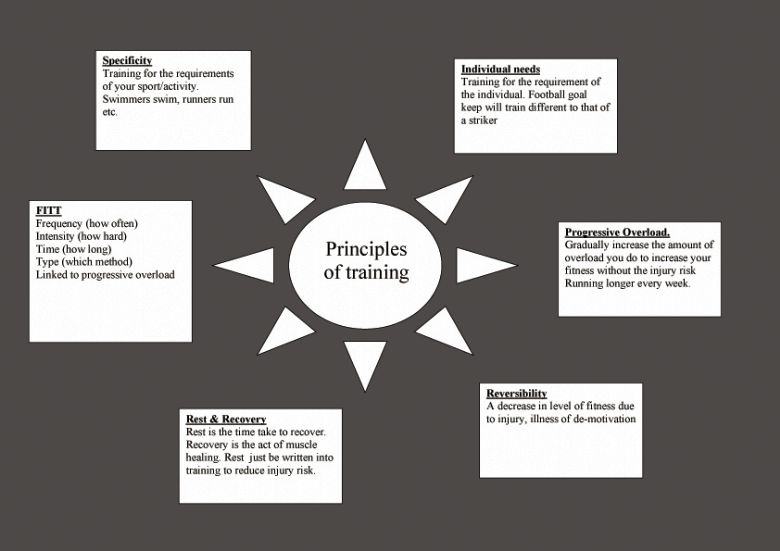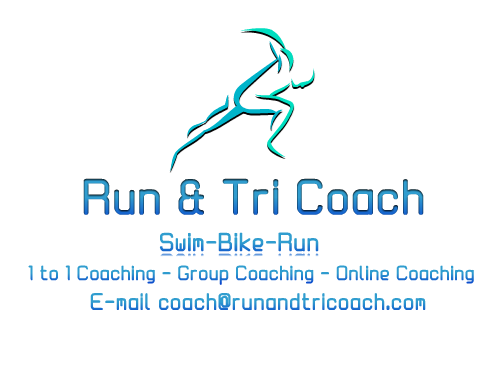Training Principles
Training, August 26, 2015
The specificity of training
Why do people get involved in physical activity?
People start participating in exercise for a lots of different reasons, to lose weight, to improve there health and physical condition or to achieve a specific goal within a sport or there personal life and by no means least to relieve stress and feel good about themselves. Participating in any form of sport whether its a team sport like rugby or a club sport like a running club, it encourages co-operation and camaraderie and develops an element of competitiveness which will challenge each individual whilst meeting new people along the way.
Principles of Training
When training to improve an athlete’s/participant’s performance these simple steps are “The Principles of Training”:- specificity, overload, recovery, adaptation and reversibility. Below there is more in depth information relating to the principles of training.
Specificity
To improve the range of movement for a particular joint action, you have to perform exercises that involve that joint action. It is quite possible for an athlete to have good mobility in the shoulder joint but to have poor hip mobility. Conducting shoulder mobility exercises may further improve the shoulder mobility but it will not affect hip mobility.
In addition to developing general levels of all round mobility in an participant, coaches need to consider the specific mobility requirements of a given event. The coach can analyse the technique of his/her event, identify which joint actions are involved and determine which need to be improved in terms of the range of movement. A thrower, for example, might require improvements in his/her shoulder and spine mobility. A hurdler might need to develop his/her hip mobility.
The amount and nature of the mobility training required by each athlete will vary according to the individual athlete’s event requirements and his/her individual range of movement for each joint action. It may be necessary to measure the range of movement for particular joint actions to determine the present range and future improvement.
Specificity is an important principle in strength training, where the exercise must be specific to the type of strength required, and is therefore related to the particular demands of the event. The coach should have knowledge of the predominant types of muscular activity associated with his/her particular event, the movement pattern involved and the type of strength required. Although specificity is important, it is necessary in every schedule to include exercises of a general nature (e.g. power clean, squat). These exercises may not relate too closely to the movement of any athletic event but they do give a balanced development and provide a strong base upon which highly specific exercise can be built.
To use heavy throwing implements or weighted belts may seem the obvious solution to the specificity problem, but it is probable that by doing so the athlete will unconsciously develop compensatory movements in his/her technique in adjusting to the new weight.
Can we be specific in the speed of movement? Training at low velocity increases low velocity strength substantially but has little effect on high velocity strength.
Is there then any justification for slow velocity strength training for athletes who have to perform movements at great speed? Yes. Slow velocity training may be of value in stimulating maximum adaptation within the muscle. When an athlete performs high velocity strength work, the force he/she generates is relatively low and therefore fails to stimulate substantial muscular growth. If performed extensively the athlete may not be inducing maximum adaptation with the muscles. It is important therefore for the athlete to use FAST and SLOW movements to train the muscles. The Long Slow Run on a sunday and the speed intervals both play vital roles in this component.
Overload
When an athlete performs a mobility exercise, he/she should stretch to the end of his/her range of movement. In active mobility, the end of the range of movement is known as the active end position. Improvements in mobility can only be achieved by working at or beyond the active end position.
- Passive exercises involve passing the active end position, as the external force is able to move the limbs further than the active contracting of the agonist muscles ( agonist muscle is the working muscle ) ( antagonist is the muscle working against the working muscle )
- Kinetic mobility (dynamic) exercises use the momentum of the movement to bounce past the active end position
A muscle will only strengthen when forced to operate beyond its customary intensity. The load must be progressively increased in order to further adaptive responses as training develops, and the training stimulus is gradually raised. Overload can be progressed by:
- increasing the resistance e.g. adding 5kg to the barbell
- increasing the number of repetitions with a particular weight
- increasing the number of sets of the exercise (work)
- increasing the intensity- more work in the same time, i.e. reducing the recovery periods
Recovery
Rest is required in order for the body to recover from the training and to allow adaptation to take place. Rest is the best form of exercise as i always say.
Adaptation
The body will react to the training loads imposed by increasing its ability to cope with those loads. Adaptation occurs during the recovery period after the training session is completed.
If exercises lasting less than 10 seconds (ATP-CP energy system) are repeated with a full recovery (approximately 3 to 5 minutes) then an adaptation in which stores of ATP and CP in the muscles are increased.
This means more energy is available more rapidly and increases the maximum peak power output. If overloads are experienced for periods of up to 60 seconds, with a full recovery, it is found that glycogen stores are enhanced.
The most noticeable effect of weight training with heavy loads on fast twitch muscle fibres is larger and stronger muscles (hypertrophy).
The rate of adaptation will depend on the volume, intensity and frequency of the exercise sessions. In recent investigation, reports that 6 weeks of low-volume, high-intensity sprint training induced similar changes in selected whole-body and skeletal muscle adaptations as traditional high-volume, low-intensity endurance workouts undertaken for the same intervention period.
The time of adaptation may be quicker for high-intensity sprint training when compared to low-intensity endurance training, but that over a longer period, the two training regimens elicit similar adaptations.
Reversibility or Detraining
Improved ranges of movement can be achieved and maintained by regular use of mobility exercises. If an athlete ceases mobility training, his/her ranges of movement will decline over time to those maintained by his/her other physical activities.
When training ceases the training effect will also stop. It gradually reduces at approximately one third of the rate of acquisition. Athletes must ensure that they continue strength training throughout the competitive period, although at a much reduced volume, or newly acquired strength will be lost
Detraining Risk
The effects of a long period of inactivity on physical fitness comes from a UK case study of an Olympic rower who took more than 20 weeks to fully recover his fitness after an eight-week lay-off.
Although the athlete in question took the time off in response to the need for a physical and mental break rather than because of illness and injury, this case study has clear implications for injured athletes.
The athlete, an elite heavyweight male rower and current Olympic champion, allowed himself the luxury of eight weeks of inactivity after competing in the Sydney Olympic Games in September 2000. His fitness was assessed by means of a lab-based incremental rowing test on four separate occasions: eight weeks before the Olympics; after eight weeks of inactivity; after eight weeks of retraining; and after a further 12 weeks of training.
The key findings were as follows: After eight weeks’ detraining
- V02peak had decreased by 8%. After eight weeks of retraining it had increased by only 4%, returning to just below pre-Olympic values after a further 12 weeks;
- Power at peak oxygen consumption fell from a pre-Olympic value of 546W to 435W – a reduction of 20%. After eight weeks’ retraining it had increased by 15%, resuming pre-Olympic values after a further 12 weeks;
- Power at reference blood lactate concentrations declined by 27%, but returned to just below or just above pre-Olympic levels after 20 weeks’ retraining.
The researchers recommend that training programs should limit periods of complete inactivity to no more than two to three weeks. Prolonged periods of inactivity should be avoided and the training programme should incorporate some form of “maintenance” training where a prolonged break is desired.

